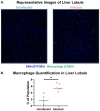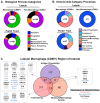Hepatic and pulmonary macrophage activity in a mucosal challenge model of Ebola virus disease
- PMID: 39635525
- PMCID: PMC11615675
- DOI: 10.3389/fimmu.2024.1439971
Hepatic and pulmonary macrophage activity in a mucosal challenge model of Ebola virus disease
Abstract
Background: The inflammatory macrophage response contributes to severe Ebola virus disease, with liver and lung injury in humans.
Objective: We sought to further define the activation status of hepatic and pulmonary macrophage populations in Ebola virus disease.
Methods: We compared liver and lung tissue from terminal Ebola virus (EBOV)-infected and uninfected control cynomolgus macaques challenged via the conjunctival route. Gene and protein expression was quantified using the nCounter and GeoMx Digital Spatial Profiling platforms. Macrophage phenotypes were further quantified by digital pathology analysis.
Results: Hepatic macrophages in the EBOV-infected group demonstrated a mixed inflammatory/non-inflammatory profile, with upregulation of CD163 protein expression, associated with macrophage activation syndrome. Hepatic macrophages also showed differential expression of gene sets related to monocyte/macrophage differentiation, antigen presentation, and T cell activation, which were associated with decreased MHC-II allele expression. Moreover, hepatic macrophages had enriched expression of genes and proteins targetable with known immunomodulatory therapeutics, including S100A9, IDO1, and CTLA-4. No statistically significant differences in M1/M2 gene expression were observed in hepatic macrophages compared to controls. The significant changes that occurred in both the liver and lung were more pronounced in the liver.
Conclusion: These data demonstrate that hepatic macrophages in terminal conjunctivally challenged cynomolgus macaques may express a unique inflammatory profile compared to other macaque models and that macrophage-related pharmacologically druggable targets are expressed in both the liver and the lung in Ebola virus disease.
Keywords: CD163; Ebola; IDO1; MAC387; liver; lung; macaque; macrophage.
Copyright © 2024 Wanninger, Saldarriaga, Arroyave, Millian, Comer, Paessler and Stevenson.
Conflict of interest statement
The authors declare that the research was conducted in the absence of any commercial or financial relationships that could be construed as a potential conflict of interest.
Figures








References
-
- Kuhn JH, Amarasinghe GK, Perry DL. Filoviridae. In: Howley PM, Knipe DM, editors. Fields virology: emerging viruses, 7th, vol. 1 . Lippincott Williams & Wilkins, Philadelphia: (2021). p. 449–503.
MeSH terms
LinkOut - more resources
Full Text Sources
Medical
Research Materials
Miscellaneous

